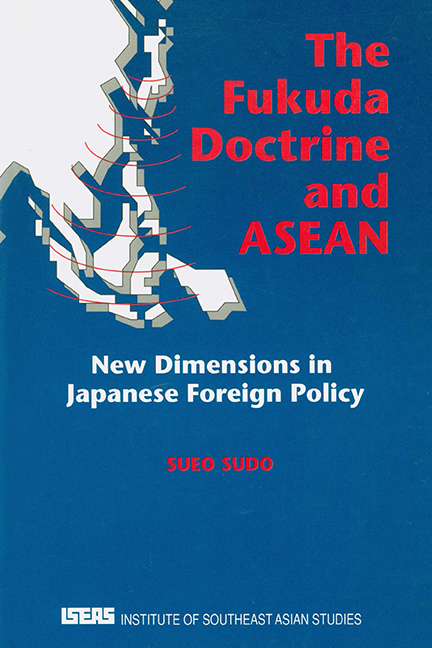Book contents
- Frontmatter
- Dedication
- Contents
- List of Tables
- Preface
- Abbreviations
- Introduction
- chapter one A Framework for Analysing Japanese Policy Towards Southeast Asia
- chapter two Post-war Japan's Re-entry into Southeast Asia
- chapter three Japan's Policy Towards Regional Development
- chapter four External Challenge and Changing Japan-Southeast Asia Relations; 1975–77
- chapter five A Changing Southeast Asia in Japanese Politics
- chapter six Formulating the First Doctrine in Japanese Foreign Policy
- chapter seven Japan's ASEAN Policy, 1977–87
- chapter eight Conclusion
- Appendices
- APPENDIX 1 Manila Speech, 18 August 1977
- APPENDIX 2 Japan's Exports to ASEAN, 1967–89
- APPENDIX 3 Japan's Imports from ASEAN, 1967–89
- APPENDIX 4 Japanese Investments in ASEAN, 1967–89
- APPENDIX 5 Japan's ODA to ASEAN, 1967–89
- Bibliography
- Index
- THE AUTHOR
APPENDIX 1 - Manila Speech, 18 August 1977
from Appendices
Published online by Cambridge University Press: 21 October 2015
- Frontmatter
- Dedication
- Contents
- List of Tables
- Preface
- Abbreviations
- Introduction
- chapter one A Framework for Analysing Japanese Policy Towards Southeast Asia
- chapter two Post-war Japan's Re-entry into Southeast Asia
- chapter three Japan's Policy Towards Regional Development
- chapter four External Challenge and Changing Japan-Southeast Asia Relations; 1975–77
- chapter five A Changing Southeast Asia in Japanese Politics
- chapter six Formulating the First Doctrine in Japanese Foreign Policy
- chapter seven Japan's ASEAN Policy, 1977–87
- chapter eight Conclusion
- Appendices
- APPENDIX 1 Manila Speech, 18 August 1977
- APPENDIX 2 Japan's Exports to ASEAN, 1967–89
- APPENDIX 3 Japan's Imports from ASEAN, 1967–89
- APPENDIX 4 Japanese Investments in ASEAN, 1967–89
- APPENDIX 5 Japan's ODA to ASEAN, 1967–89
- Bibliography
- Index
- THE AUTHOR
Summary
My journey through Southeast Asia, which began in Kuala Lumpur with my meetings with the leaders of ASEAN, is now approaching its end. I am delighted, as a kind of finishing touch to this journey, to be able to share my ideas with you, here in the Republic of the Philippines, our nearest neighbour in the distinguished presence of one of Asia's most eminent leaders, and my close friend, President Marcos.
Let me begin with one strong impression I gained from my tour. It was the spectacular and rich diversity of the area I have just visited, the diversity in ethnic composition, language and religion, in the cultural impact of distinct histories, and in economic structures. Southeast Asia is by no means a homogeneous or uniform part of the world. It is no wonder that some have been sceptical of the prospects for intraregional co-operation in this area. Yet, the Association of Southeast Asian Nations, which has just celebrated its tenth anniversary, is now in the process of firmly establishing itself as a self-reliant organization for regional co-operation in the area. The first Summit conference in Bali was a milestone in progress toward solidarity, and the success of the Summit conference which has just ended confirms the belief that the determination of the ASEAN members to strengthen their solidarity is now irreversible.
ASEAN is, indeed, a historic and successful attempt to seek and create a regional identity of this area through the strengthening of solidarity while affirming the rich diversity of its membership, and respecting the proud nationalism of each member country. I saw, and was impressed by one expression of these creative efforts, the ardent dedication to solidarity of the ASEAN leaders whom I had the pleasure of meeting in Kuala Lumpur. The solidarity of ASEAN, strengthened by the success of co-operative undertakings, in turn opens up new opportunities for useful collaboration, thus further strengthening solidarity. This dynamic and self-reinforcing process will, I believe, characterize the future course of ASEAN.
- Type
- Chapter
- Information
- The Fukuda Doctrine and ASEANNew Dimensions in Japanese Foreign Policy, pp. 241 - 247Publisher: ISEAS–Yusof Ishak InstitutePrint publication year: 1992

